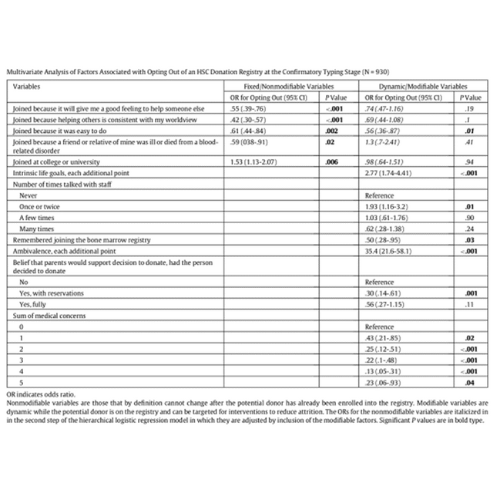Research published in Transplantation and Cellular Therapy reviewed factors associated with potential hematopoietic cell transplantation (HCT) donors opting out of donation from national unrelated donor registries. This study surveyed potential HCT donors aged 30 and younger enrolled on national unrelated donor registries, including the Be The Match Registry®. Results showed that potential donors who expressed ambivalence, religious objections, mistrust or concerns regarding the process, and had limited contact with registry staff were associated with opting out of donation.
In contrast, potential donors who remembered joining the registry, those who believed that parents would support donation, and those with donation-related medical concerns were associated with continuing to donate. These results suggest possible approaches that national registries could consider to improve donor availability.
Background
Young adults enrolled on unrelated donor registries often opt out of continuing the donation process for HCT when a potential recipient is identified. The differences in demographic, psychosocial, registry-related, and donation-related characteristics between donors who continue to donate and those who opt out have not been extensively studied in donors up to age 30. However, understanding these differences may clarify any modifiable risk factors that can be addressed.
Study Details
The study cohort included 935 randomly selected potential donors ages 18-30 whom National Marrow Donor Program® (NMDP)/Be The Match® had recently contacted about a possible recipient from July 2016-December 2018 at the confirmatory typing (CT) stage of the donation process. Participants completed an online survey and were compensated once the survey was complete. Participants were divided into two groups: those not interested in donation (CT-NI) and those who continued to CT (CT-C).
Results
There was a significant difference in racial and ethnic distribution between the two groups, with more Black participants in the CT-NI (24% vs. 18%) and more multiracial/multiethnic participants in the CT-C group (13% vs. 7%). The proportion of participants who had previously donated blood, plasma, or platelets was significantly lower for the CT-NI group than the CT-C group (49% vs. 56%). The CT-NI group had higher allocation mistrust, religious objections, and concerns regarding donation than the CT-C group. Donation-related knowledge was higher in the CT-C group than in the CT-NI group (surveys were completed before donation for those in the continuing group).
After adjusting for covariates in a logistic regression model, researchers found that having more intrinsic life goals, greater ambivalence, and talking with registry staff only once or twice were significantly associated with opting out of donating, as shown in Figure 1. Ambivalence had the strongest association with opting out.
The non-modifiable variables associated with opting out included donors stating they joined because: it would feel good to help someone else, helping others is consistent with a worldview, it was easy to do, or a friend or relative died from a blood-related disorder. In addition, joining at a college or university was associated with opting out.
The dynamic or modifiable variables associated with continuing toward donation included the participant: remembering signing up on the registry, believing that parents would support the donation (either entirely or with reservations), and citing donation-related medical concerns.
Key Takeaways
According to the NMDP/Be The Match, an average of 55-60% of all potential donors are available at the CT stage annually, while 14-16% are designated as not interested. Results suggest that national unrelated donor registries could consider increasing contact between donors and staff, reducing ambivalence, assisting with parental support of the donation process, and enhancing education on the risks and benefits of donation to improve donor availability for HCT.
These strategies can potentially increase donor participation and knowledge of the donation process, likely alleviating concerns and mistrust associated with opting out of donation. The NMDP/Be The Match is committed to providing education and awareness regarding donation to increase access to all patients who need transplantation.
Figure 1. Multivariate Analysis of Factors Associated with Opting Out

Hamed AB, et al., Published in Transplantation and Cellular Therapy
